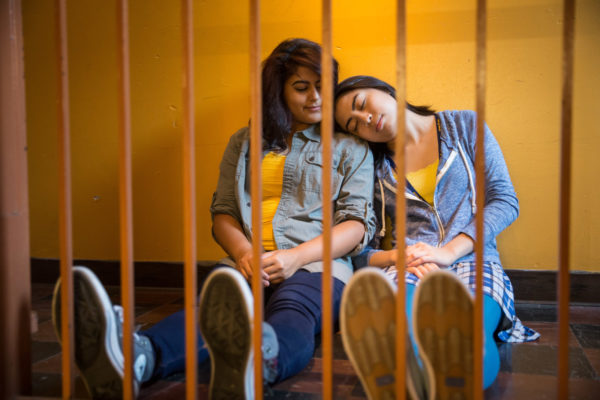The prospect of reliving high school, even for just two hours, may not sound like everyone’s idea of a good time. And Learning Curve—the latest project from the stellar youth-theater program Albany Park Theater Project, working for the first time with Brooklyn immersive-theater specialists Third Rail Projects—might prompt some audience members cast as “students” to wish for trigger warnings.
For the show, Third Rail, a cadre of directors and the large youth ensemble (who portray everyone from students to teachers to security guards) have transformed a decommissioned Catholic school in Logan Square into the fictional Chicago Public Schools facility “Ellen Gates Starr High School.” And in giving us glimpses into a day in the life of a CPS student today, well, Learning Curve is bound to bring us across some rough patches.
After entering through the metal detector and being photographed for your personal student ID, the audience is divided and redivided onto seemingly dozens of potential performance tracks; if you attend with friends, expect to be split up. Depending on the path you’re assigned, you’ll experience a number of vignettes throughout the four-story building, some in groups, some in pairs or on your own. My sense is that no two audience members see all of the same scenes in a given performance.
In my own experience, I found myself tearing up on multiple occasions, variously out of sadness, frustration or hope. Those occasions included a solo encounter with a newly laid-off teacher packing up her things; finding myself and another “student” watching helplessly and infuriatingly as a boy was bullied by two others in a bathroom; and hearing a student who struggled to express his thoughts about The Great Gatsby in English class open up eloquently about the book’s themes in Spanish.
It’s easy enough to marvel at the technical achievement of the youngsters keeping this massive mechanism moving smoothly night after night. But it’s more important to absorb what they’re asking us to experience of the reality they and their fellow students—and teachers, and administrators, and parents—face day to day and year to year.
When you’re a teenager, the smallest victories and slights can feel like matters of life and death. But it’s also true that, in the fragile CPS ecosystem, the life and death of a school and its future students can always be at stake.
At one point I found myself filling out a Scantron and taking a standardized test in math—panic-inducing enough when I had to do it a couple of decades ago. But I never had a proctor reminding me that my school’s future budget could hinge on the numbers we put up that day. All the newspaper stories in the world can’t convey that pressure as well as hearing it with the pencil in your hand.
For the show, Third Rail, a cadre of directors and the large youth ensemble (who portray everyone from students to teachers to security guards) have transformed a decommissioned Catholic school in Logan Square into the fictional Chicago Public Schools facility “Ellen Gates Starr High School.” And in giving us glimpses into a day in the life of a CPS student today, well, Learning Curve is bound to bring us across some rough patches.
After entering through the metal detector and being photographed for your personal student ID, the audience is divided and redivided onto seemingly dozens of potential performance tracks; if you attend with friends, expect to be split up. Depending on the path you’re assigned, you’ll experience a number of vignettes throughout the four-story building, some in groups, some in pairs or on your own. My sense is that no two audience members see all of the same scenes in a given performance.
In my own experience, I found myself tearing up on multiple occasions, variously out of sadness, frustration or hope. Those occasions included a solo encounter with a newly laid-off teacher packing up her things; finding myself and another “student” watching helplessly and infuriatingly as a boy was bullied by two others in a bathroom; and hearing a student who struggled to express his thoughts about The Great Gatsby in English class open up eloquently about the book’s themes in Spanish.
It’s easy enough to marvel at the technical achievement of the youngsters keeping this massive mechanism moving smoothly night after night. But it’s more important to absorb what they’re asking us to experience of the reality they and their fellow students—and teachers, and administrators, and parents—face day to day and year to year.
When you’re a teenager, the smallest victories and slights can feel like matters of life and death. But it’s also true that, in the fragile CPS ecosystem, the life and death of a school and its future students can always be at stake.
At one point I found myself filling out a Scantron and taking a standardized test in math—panic-inducing enough when I had to do it a couple of decades ago. But I never had a proctor reminding me that my school’s future budget could hinge on the numbers we put up that day. All the newspaper stories in the world can’t convey that pressure as well as hearing it with the pencil in your hand.
 Menu
Menu
